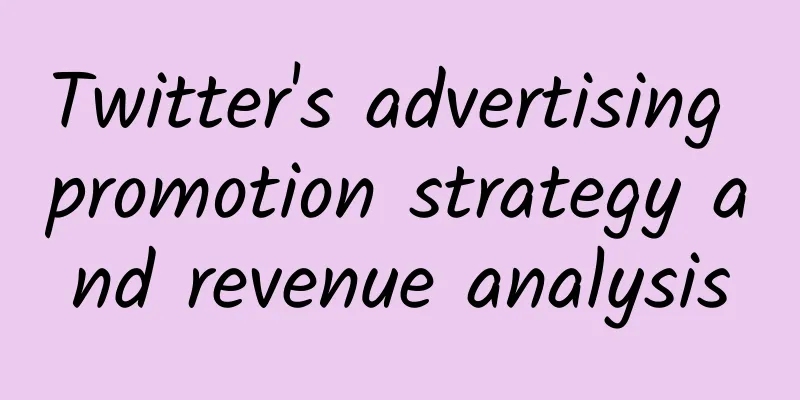Twitter's advertising promotion strategy and revenue analysis

|
The topic of Twitter's business operation has always attracted much attention. "How to make money with hundreds of millions of users?" is always a hot topic of discussion among investors, business directors, and product managers. Various signs show that Twitter's advertising business attempts have begun to bear fruit, and this road is getting wider and wider. Currently, Twitter has three main types of advertising products: Promoted Trends, Promoted Accounts, and Promoted Tweets. Let’s take a look at how they work in turn. Twitter Trends Advertisers can purchase discussion positions for hot topics and place ads at the top of tweets discussing hot topics, as shown in the figure below: The highlight of this type of advertising is that it can trigger discussions among users about the brand and expand the brand's influence. For example, Coca-Cola, as the second largest buyer of Promoted Trends, purchased ads that appeared 86 million times and had a user engagement rate of up to 6%. Twitter Accounts Using paid Twitter promotion accounts can create a more professional image. Twitter works by allowing specific accounts to gain more attention, as shown below: Twitter Tweets Advertisements are Twitter's flagship product. They appear mainly at the top of search results for related topics and in the user's timeline: As the most powerful and profitable of Twitter's advertising products, Ad Push is an important representative of Twitter's advertising business exploration. Let's take a look at its relevant data: ·2010 Twitter first introduced Promoted Tweets In 2010, Twitter launched its first advertising product, Promoted Tweets, which is similar to Google's AdWords system and is related to search keywords, which is equivalent to selling "keywords". New model launched in July 2011 Twitter announced a new advertising model on its official blog: Timely Tweets. Simply put, Twitter will start adding ads (commercial and public welfare) to the timeline. Here's how ads work: If you follow promoted tweets, they will appear at the top of your timeline every time you log in to Twitter. When the timeline is updated, the promoted tweets will sink normally. The promoted tweets are clearly marked with an orange arrow and a "promoted" label below them. In September 2011, the company changed its advertising policy again to test users’ bottom line – boiling a frog in warm water? In Twitter's previous advertising policy, the prerequisite for ads to appear at the top of the timeline was that users had to follow the recommended account. The new policy now removes this prerequisite. Currently, such ads will only appear on twitter.com. Twitter's behavior seems to be constantly testing the bottom line of users, which can be described as a common saying: boiling a frog in warm water. Twitter advertising revenue According to eMarketer's survey data, Twitter's advertising revenue in 2010 was 45 million US dollars. In 2011, eMarketer predicts that Twitter's advertising revenue will grow 210% to $139.5 million. In 2012, Twitter's advertising revenue is expected to reach $260 million. In 2013, the figure was $400 million. The good and bad of advertising models Judging from the data, Twitter's advertising path seems to be relatively smooth. BusinessInsider commented on this business model: • Twitter's advertising business is in its early stages of development. Currently, Twitter's "ads" only appear on the Twitter homepage. Soon they will also appear in Twitter's broader application ecosystem, and Twitter's advertising system is constantly improving. • Twitter ads will be adopted by marketers on a large scale. Twitter charges for ads based on the “engagement” of Twitter users (clicks, replies, retweets, and follows on “ad tweets”). This type of ad can trigger social media conversations about a brand. This will become a tried-and-true advertising tool for marketers. • Twitter is an alternative TV. Twitter is a channel that lets you watch what the world (or your friends) are experiencing, but unlike traditional TV, you won't be interrupted by too many commercials. And, generally speaking, these commercials are not only profitable for advertisers, but also beneficial to users because of their relevance. Are users strongly disgusted? Ads are annoying no matter what, but Twitter is doing its best to make them less annoying. BusinessInsider's Ellis Hamburger said: I found that "ad pushes" are not much different from TV commercials - short commercials inserted into the content you are watching. The difference is that advertising push is not that annoying because it has a strong timeliness, is very short, and most of them appear in the form of celebrities expressing their own ideas. In fact, since Twitter's ads are very low-key, apart from a simple ad logo, they are not much different from ordinary tweets. So most users don't care much. Instead, they think that this kind of ads bring effective information. Of course, there are a small number of people who are disgusted by this. When I went to the Twitter Help Center to look up the relevant information for this article, I found that the comment section below the Twitter advertising product introduction was full of users' dissatisfaction. One user wrote: Thanks, but I don't need them. I don't want ads in my timeline because they are ads. They are annoying and I can't turn them off. So please delete them or remove me from the promotion user list...thank you. Fortunately, Twitter's attempts to run ads have not yet sparked a massive user revolt, as happened with Facebook's new version of its homepage. What's next? Dick Costolo, CEO of Twitter, said at the Web 2.0 Summit that Twitter's advertising performance is as good as it can be. He also revealed that Twitter will introduce more forms of advertising, such as videos and pictures. But he also said that the specific method depends on the user's acceptance. Twitter hopes to go further and further on the road of advertising while ensuring user experience. As Jack Dorsey, another founder of Twitter, said when asked about the advertising business at Technomy 2011: "User experience is the most important. If the user experience deteriorates, then we have failed." Original link: ifanr.com/62032 |
Recommend
What if you catch a cold during confinement? You still need to eat to increase your immunity
Women who catch a cold during the confinement per...
Can I test for pregnancy if my period is delayed for four days?
It is normal for women to have their periods ever...
A woman feels a hard lump in the right lower abdomen
If there is a lump in the abdomen, you can touch ...
What are the causes of small bumps in the vagina?
Gynecological diseases are a relatively common di...
[Fat Bear Science] A "cyst" was found on the liver during a physical examination. Is it cancer? How to treat it? Click here to find out
"Doctor, I have a 3 cm cyst on my liver. Is ...
The harm of low skeletal muscle in girls
From a clinical medical point of view, skeletal m...
How long does it take to do a vaginal ultrasound during pregnancy?
Many people think that it is unsafe to do a vagin...
What to do if your gums bleed during late pregnancy
When you are about to give birth, the most feared...
Can I eat wontons during my period?
Wontons are one of the foods that everyone loves ...
Diet therapy for hair loss on the top of girls' heads
Hair loss is very common. Many people have experi...
Vitamin E in pregnant women
Pregnant women should pay attention to their diet...
What does it mean when a pregnancy test shows negative
The use of pregnancy test sticks can detect wheth...
What kind of instrument is guitar? How do guitar beginners practice strumming?
Guitar is a string instrument, which is the main ...
I feel a little pain when my nipples are pinched
Women must take care of their breasts on a regula...
There is a hard lump near the vaginal opening
The vagina is the female reproductive organ, and ...









